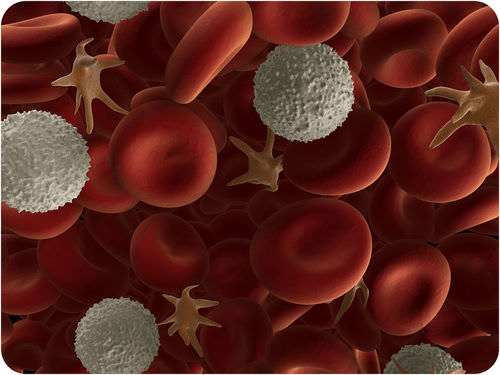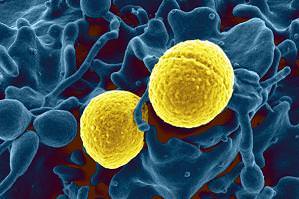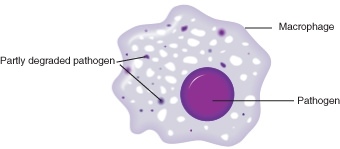11.2 炎炎反应
章节大纲
-
What happens when an enemy gets past the first line of defense?
::当敌人越过第一道防线时会怎样?For this running back to make it past the first line of defense, there usually has to be a hole or break in the line. He then runs into the secondary, or the second line of defense. Whenever the skin is broken, it is possible for to easily enter your body. They get past the first line of defense and run into the second line of defense.
::要想回到第一道防线, 通常必须有一个洞或突破防线。 然后他跑到第二道或第二道防线。 当皮肤骨折时, 很容易进入你的身体。 他们越过第一道防线, 跑到第二道防线。Second Line of Defense
::第二防线第二防线If you have a cut on your hand, the break in the skin provides a way for pathogens to enter your body. Assume enter through the cut and infect the wound. These bacteria would then encounter the second line of defense.
::如果你手上有割伤,皮肤的断裂为病原体进入你的身体提供了一条途径。从伤口中穿入伤口并感染伤口。这些细菌将遇到第二道防线。Inflammatory Response
::炎炎反应The cut on your hand is likely to become red, warm, swollen, and painful. These are all signs that an inflammatory response has occurred. An inflammatory response is a complex biological reaction to tissue damage. It is one of the first responses of the immune system to infection or injury. Inflammation is triggered by chemicals called cytokines and histamines , which are released when tissues are damaged.
::你手上的伤口很可能会变成红色的,温暖的,肿胀的,痛苦的。这些都是发炎反应的迹象。炎反应是对组织损伤的复杂的生物反应。这是免疫系统对感染或伤害的最初反应之一。发炎是由称为细胞皮和脑胺的化学物质引发的,在组织受损时会释放出这些化学物质。-
Cytokines
are chemical signals used to
communicate
between
.
::Cytokines是化学信号 用来在 。 -
Histamines
are chemicals that cause inflammation and
.
::直胺是引起炎症的化学品。
The cytokines and histamines released when tissue is damaged cause many changes in the damaged tissue. The changes help remove the cause of the damage and start the healing process. For example, the chemicals cause local to dilate, which increases flow to the area. They also cause other changes in blood vessels that allow blood components to leak into the damaged tissue.
::组织受损时释放出细胞皮和脊髓胺,导致损伤组织发生许多变化。这些变化有助于消除损伤原因并开始愈合过程。例如,化学物质导致局部膨胀,从而增加向该地区的流动。它们还导致血液血管的其他变化,使血液成分渗入受损组织。This drawing shows what happens during the inflammatory response. Why are changes in capillaries important for this response?
::这张图显示了煽动性反应期间发生的情况。 为什么毛毛线变化对这一反应很重要?White Blood Cells
::白血细胞In this image, leukocytes (white) are attacking pathogens (star-shaped).
::在这个图像中,白白正在攻击病原体(恒星形)。Another role of cytokines is to attract white blood cells , or leukocytes , to the site of inflammation. Leukocytes are immune system cells that are specialized to fight infections. They are the primary cells of the immune system and are found throughout the body. The general function of leukocytes is to identify and eliminate pathogens, debris, and abnormal . Figure shows several different types of leukocytes. Each type plays a different role in the removal of pathogens and other unwanted substances from the body.
::白细胞的另一个作用是将白血球或白血球吸引到发炎地点。白细胞是免疫系统细胞,专门用来防治感染。它们是免疫系统的主要细胞,在身体上可以发现。白细胞的一般功能是识别和消除病原体、碎片和异常。图显示几种不同的白细胞。每种类型在从身体中清除病原体和其他不想要的物质方面都起着不同的作用。Types of Leukocytes.
::白喉类。Some leukocytes are nonspecific and respond in the same way to most pathogens. Nonspecific leukocytes include monocytes, macrophages, neutrophils, eosinophils, and basophils. These leukocytes are part of the second line of defense. A magnified image of an actual macrophage is shown in Figure .
::有些白血球不具有特定性,对大多数病原体的反应方式相同。非特定白血球包括单细胞、巨型白细胞、中微营养素、亚骨质生物和basophils。这些白血球是第二线防御的一部分。图中显示的是实际巨细胞的放大图象。A magnified image of a macrophage (blue).
::大型巨型(蓝色)放大图像。Monocytes, macrophages, and neutrophils destroy pathogens in the blood and tissues by phagocytosis . Phagocytosis is the process of engulfing and breaking down pathogens and other unwanted substances. Phagocytosis of a pathogen by a macrophage is illustrated in Figure . Once a pathogen has been engulfed, it is broken down within the macrophage. Macrophages are found in tissues, and monocytes and neutrophils are found in the blood.
::单细胞、巨细胞和中微营养素通过发细胞病,在血液和组织中摧毁病原体。光细胞病是吞没和分解病原体和其他不想要的物质的过程。图中显示了巨细胞病原体的细胞病理。病原体一旦被吞没,就会在巨细胞中分解。组织中发现了巨细胞,血液中也发现了单细胞和中微营养素。Phagocytosis by a macrophage.
::由巨孔形成的地细胞。Both monocytes and neutrophils migrate through the bloodstream to sites of inflammation. Neutrophils are the most common leukocytes and are usually the first leukocytes to arrive at the scene of infection. Neutrophils and dead pathogens are the main components of pus.
::单细胞和中微营养素通过血液流迁移到发炎地点,神经营养素是最常见的白鲸,通常是第一批到达感染地点的白鲸,神经营养素和死亡病原体是肺炎的主要成份。In addition to phagocytosis, both monocytes and phagocytes produce chemicals, such as cytokines, that cause inflammation and fever. A fever is a higher-than-normal body temperature that may help fight infection. Monocytes or macrophages may also trigger the third line of defense .
::发烧是一种高于正常的体温,可能有助于抵抗感染,单细胞或大型细胞也可能触发第三防线。Eosinophils and basophils are responsible for allergies . Eosinophils also help fight infections by combating parasites such as . Basophils release cytokines, histamines, and other chemicals that contribute to inflammation as well as allergies.
::食肉动物和嗜血动物负责过敏,食肉动物也通过防治寄生虫(如巴索非生物释放细胞外皮、甲胺和其他导致炎症和过敏的化学品)来帮助防治感染。Lymphocytes are different from these nonspecific leukocytes. Lymphocytes launch an attack that is tailored to a particular pathogen. For example, some lymphocytes attack only herpes , and others attack only flu viruses. This is called a specific defense .
::淋巴细胞与这些非特定白血球不同。 淋巴细胞发起针对特定病原体的攻击。 例如, 一些淋巴细胞只攻击, 另一些只攻击流感病毒。 这被称为一种特定防御。Summary
::摘要-
Inflammation acts as a second line of defense when tissue is damaged.
::当组织受损时,燃烧是第二防线。 -
Inflammation is triggered by chemicals called cytokines and histamines, which are released when tissues are damaged.
::称为细胞皮和甲胺的化学品引发了发火,在组织受损时释放出来。 -
These chemicals cause local blood vessels to dilate, which increases blood flow to the area. They also cause other changes in blood vessels that allow blood components to leak into the damaged tissue.
::这些化学物质导致当地血管膨胀,增加进入该地区的血液流量,还造成血液血管的其他变化,使血液成分渗入受损组织。 -
The general function of leukocytes is to identify and eliminate pathogens, debris, and abnormal body cells.
::白血球的一般功能是查明和消除病原体、碎片和异常身体细胞。 -
Nonspecific leukocytes include monocytes, macrophages, neutrophils, eosinophils, and basophils.
::非特定白血球包括单细胞、巨细胞、中微营养素、骨质生物和巴索菌。 -
Monocytes, macrophages, and neutrophils destroy pathogens in the blood and tissues by phagocytosis.
::单细胞、巨细胞和中微营养素通过发细胞病摧毁血液和组织中的病原体。 -
Eosinophils and basophils are responsible for allergies. Eosinophils also help fight infections by combating parasites such as protozoa.
::消毒剂和嗜血杆菌负责过敏,消毒剂也通过防治原生动物等寄生虫来帮助防治感染。
Review
::回顾-
What are some common signs of inflammation?
::什么是一些常见的发炎迹象? -
What roles do cytokines and histamines play in the inflammatory response?
::细胞外皮和甲胺在煽动性反应中起什么作用? -
Which leukocytes are specific, and which are non-specific?
::哪种白血球是具体的,哪些是不具体的? -
Which leukocytes are responsible for allergies?
::哪个白血球对过敏负责? -
How do monocytes, macrophages, and neutrophils destroy pathogens?
::单细胞、巨细胞和中微营养素如何摧毁病原体?
-
Cytokines
are chemical signals used to
communicate
between
.





